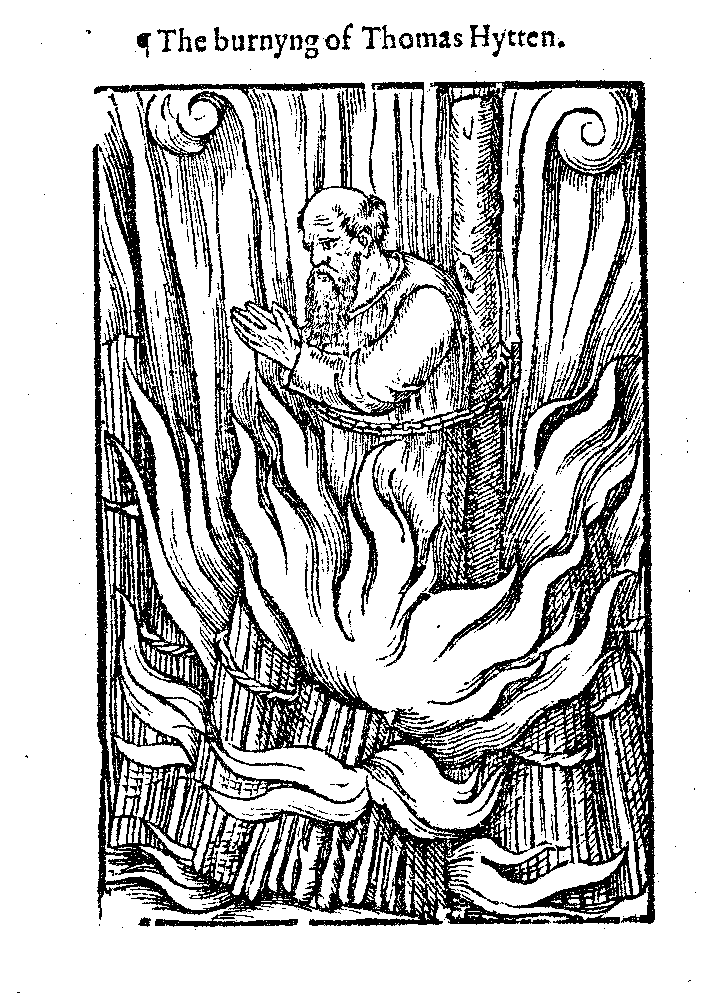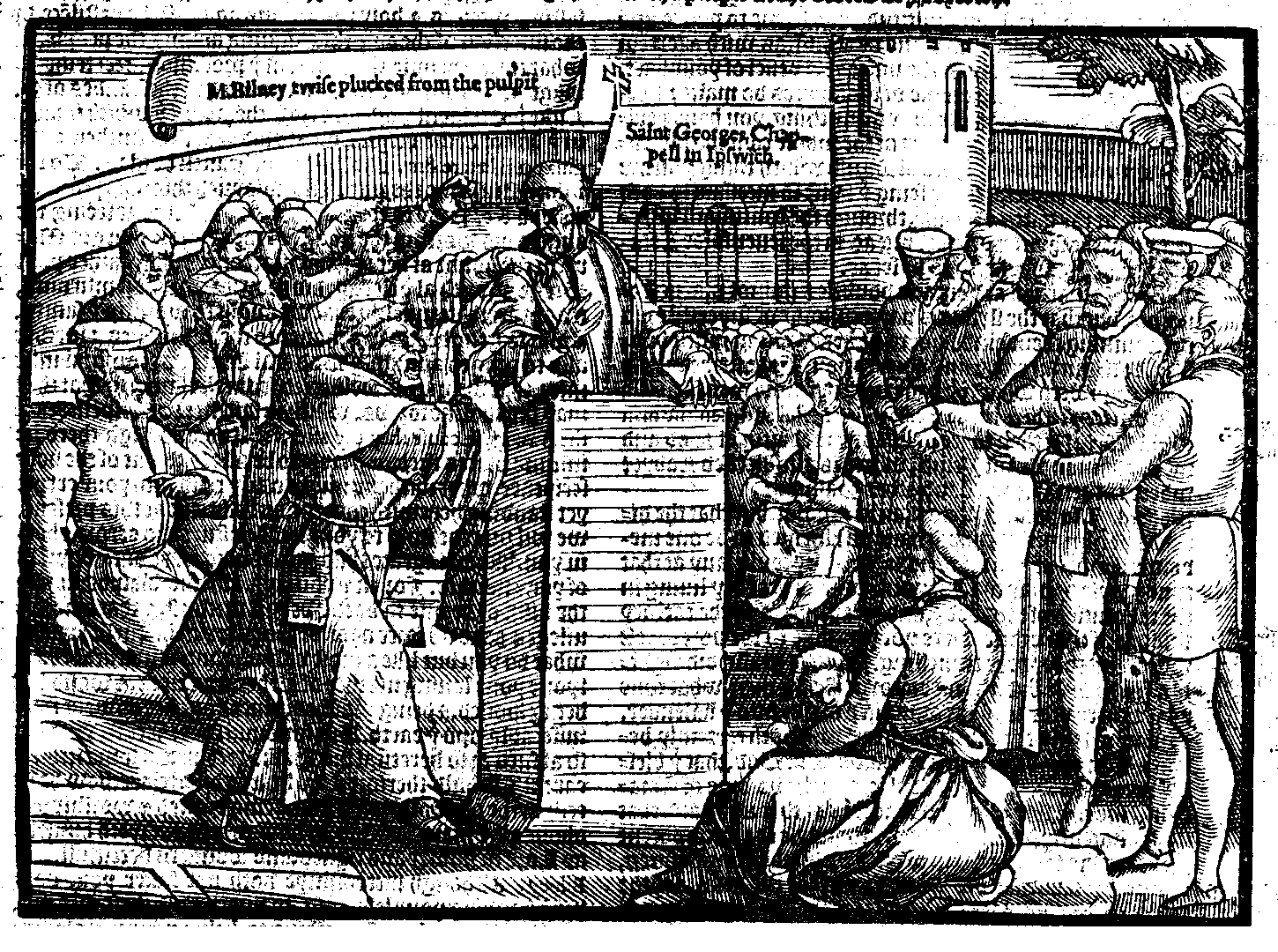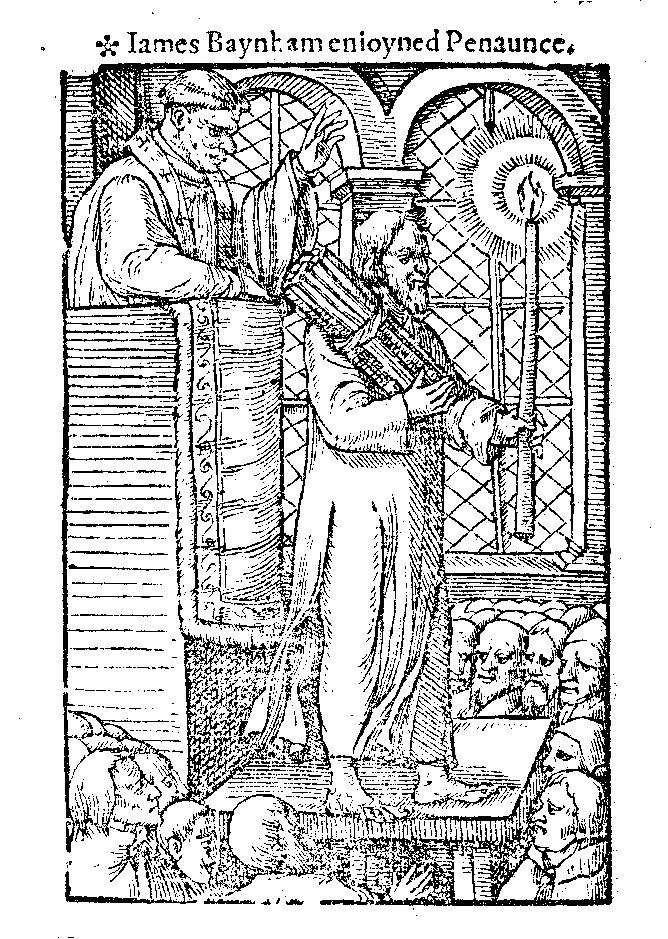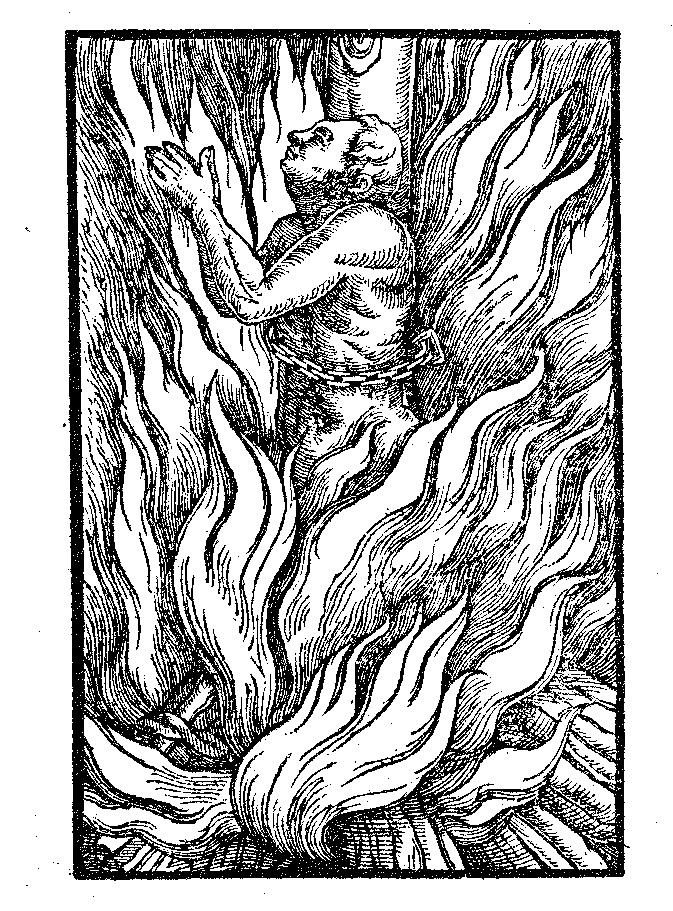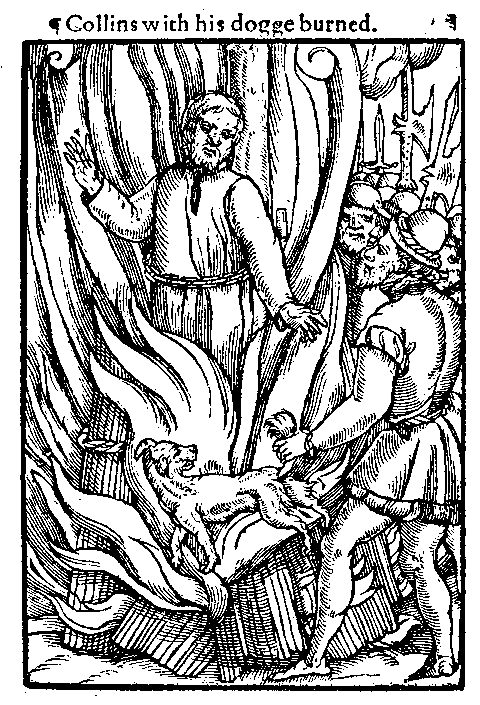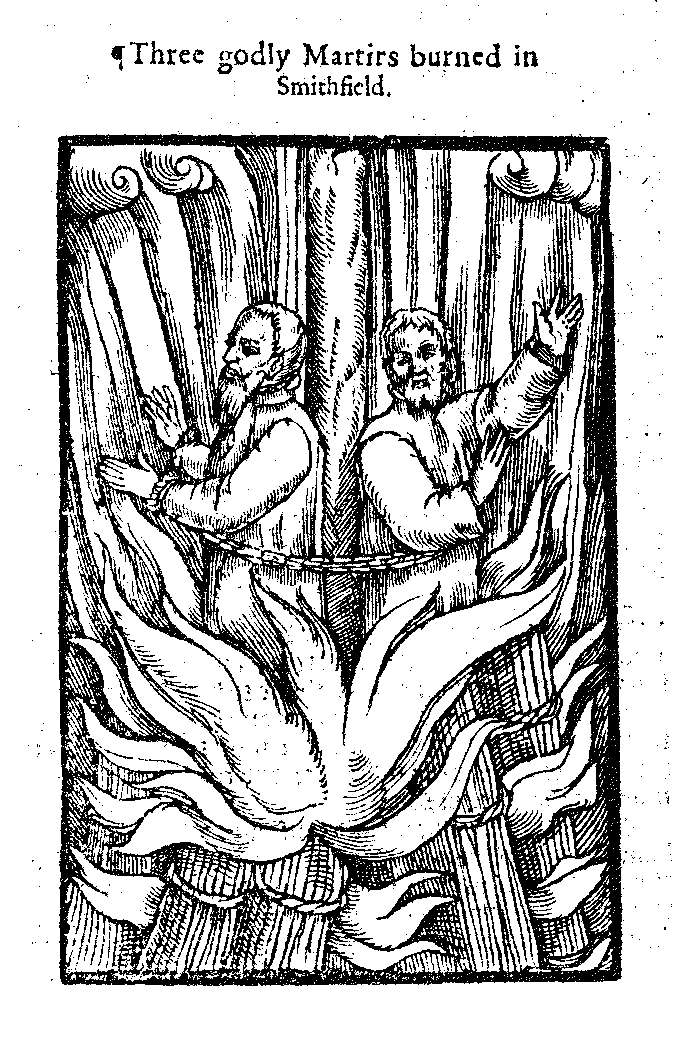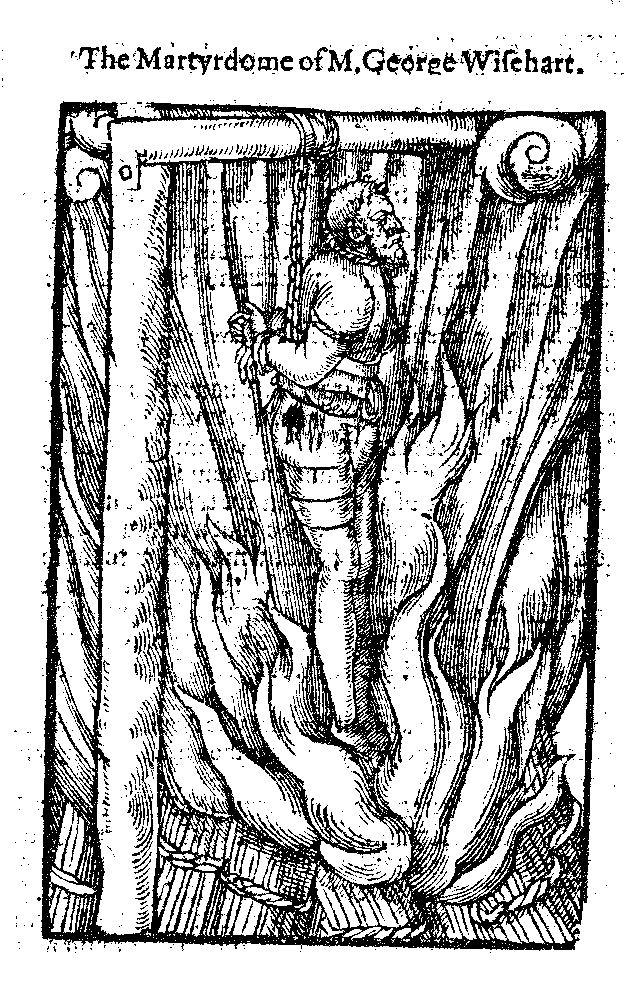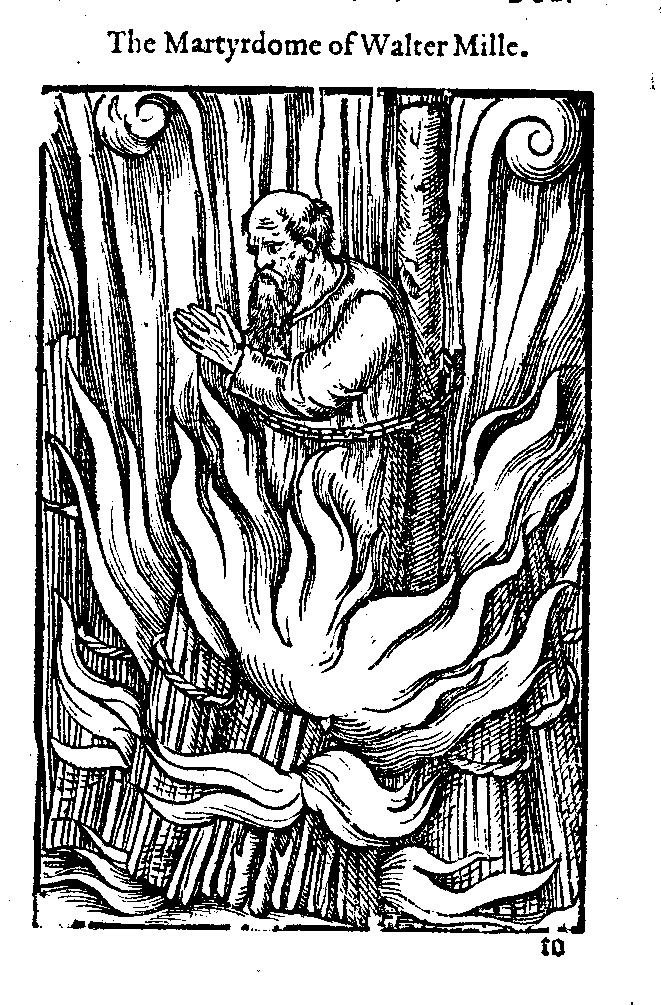Commentary on the TextCommentary on the GlossesCommentary on the WoodcutsLatin/Greek TranslationsCattley Pratt ReferencesThematic DivisionsTextual TranspositionsTextual VariationsGlossary of PeopleGlossary of PlacesEssaysBibliographyAbbreviations
Vii. Godly Martyrs in Couentrie, burnedThe burnyng of Thomas Hytten.M. Bilney twise plucked from the pulpit.A description of the godly constancy of Thomas Bilney,...The Martyrdome of Richard Bayfield.Iames Baynham enioyned Penaunce.The burning of Iames Baynham.John Bent, MartyrRobert King, Robert Debnam, and Nicholas Marshe hanged...The burning of Iohn Frith, and Andrewe Hewet. Alternative...The burning of Thomas Benet.The description and manner of the burning of Master...The order and maner of the burning of the constante...Collins with his dogge burned.The burnyng of one Peke, at Ipswich.The description of the death and burning of the most...The death and Martyrdome of Damlyp.The burning and Martyrdome of Kerby.The order and maner of the burning of Anne Askew, Iohn...The Martydome of M. Geoerge Wisehart.The burnyng of the blessed Martyr Adam Wallace.The Martydome of Walter Mill.Anglici Matrimonii (The coat of arms of Pope Julius II)
Commentary on the Woodcuts for Book 8
Vii. Godly Martyrs in Couentrie, burned
This was not the only occasion when one of the small woodcuts introduced in 1570 celebrated the martyrdom of seven individuals. But this event took place in 1519, long before the Marian burnings, and the illustration (like other later ones) may seem more generic than accurate in that it shows two women among the seven whereas, as the text makes clear, there was only one woman, Mistress Smith.
1570 Edition, page 1146 | 1576 Edition, page 970 | 1583 Edition, page 997[Back to Top]The burnyng of Thomas Hytten.
Thomas Hitton may only feature as a footnote (if that) in modern histories of the English Reformation. In his day it was different. As an early martyr of a new credal generation he sparked new admiration. Stemming from Martham in Norfolk (Foxe tells us), which had been a home of Lollards a hundred years earlier, he was sentenced by Archbishop Warham and burned at Maidstone (where he had been preaching) in February 1530. Already in 1531 Hitton's name appeared as that of a saint in the calendar of an unorthodox primer -- something that appalled Thomas More who regarded him as learning false faith and heresy from Tyndale's books
1570 Edition, page 1173 | 1576 Edition, page 995 | 1583 Edition, page 1022[Back to Top]M. Bilney twise plucked from the pulpit.
The woodcut shows Thomas Bilney being manhandled by two ugly visaged friars who pull him out of the pulpit (a portable wooden one) outside the church of St George in Ipswich. (Bilney is known to have preached at Christchurch in Ipswich). The words in the banderoles in 1563 and 1570 respectively caption the scene as 'p[f]riers pulling Bilney out of the pulpit' and 'M. Bilney twice plucked from the pulpit'. He was accused of having preached in 1527 against false belief in the spiritual value of being buried in a Franciscan habit. This illustration is related both in style and content to a woodcut of Envy that appeared in 1569 in Stephen Bateman's A christall glasse, also published by John Day. CUL copy: detail is added to this illustration in black ink. The additional detail in one figure, dressed in blue (second from the right), has, however, made him cross-eyed. WREN copy: the trees to the right are coloured in a very bright green. The figure in blue (same figure as that in blue in the CUL copy) is not cross-eyed in this copy.
1563 Edition, page 526 | 1570 Edition, page 1177 | 1576 Edition, page 998 | 1583 Edition, page 1025[Back to Top]A description of the godly constancy of Thomas Bilney, who being in prison, oftentimes prooued the fire with his finger.
Preparing for, or being tested in advance for the ordeal of burning by a flame recurs in Foxe's book. See for instance Bonner's burning of Thomas Tomkins' hand, and the burning of Rose Allin's hand. Bilney's self-testing was of a different order, but it was the same proof -- the human ability to meet an ultimate ordeal; spiritual triumph over physical pain. The unnaturally radiant light of the candle (which may itself be read as a symbol of divine revelation) is a blazon of his success. James Truman has recently posited a very different interpretation of this picture, arguing that it depicts Bilney in a homosexual relationship. He maintains, we would argue erroneously, that this woodcut 'exposes the interplay between the suffering of martyrdom ... and the physical intimacy of early modern male friendship'. He cannot account for the total lack of comment to this effect by Foxe's contemporaries or by subsequent generations of theologians or scholars. This image has no heading in the first edition in which it is set awkwardly on the page, squashed into the bottom left corner of the opening -- its left edge reaching far into the margin -- and with the text butting right up to it on the top and right side. CUL copy: the flames in this image are a very bright orange, with their centres depicted in yellow, their tips in red. The book clasps are also depicted in red. Bilney is dressed in brown. WREN copy: this is a much paler image than that in CUL.
1563 Edition, page 534 | 1570 Edition, page 1190 | 1576 Edition, page 1009 | 1583 Edition, page 1036[Back to Top]The Martyrdome of Richard Bayfield.
Richard Bayfield, sometime monk of Bary St Edmunds, who learned the new learning from Robert Barnes (which took him into the abbey prison), migrated to Cambridge and made further advances in 'good letters' -- as Foxe called the work of Tyndale and others. He became a major colporteur of prohibited reformation books, going abroad to send into England consignments of works by Luther, Zwingli and others , imported in multiple copies. Bayfield was finally arrested at a London bookbinder's in October 1531, and interrogated by Sir Thomas More. He was tried by Bishop Stokesley of London and burned as a relapsed heretic on 27 November. CUL copy: there is considerable additional pen detail in this image.
1570 Edition, page 1204 | 1576 Edition, page 1020 | 1583 Edition, page 1048[Back to Top]Iames Baynham enioyned Penaunce.
This woodcut gives a rare and graphic impression of the discipline of penance, showing the guilty man standing barefoot in his white garment, holding the lit candle and symbolic bundle of faggots, while the priest presides over the ceremony and the congregation bears witness below. Bainham did not prove penitent for long and was burned only two months later.
1570 Edition, page 1209 | 1576 Edition, page 1025 | 1583 Edition, page 1053[Back to Top]The burning of Iames Baynham.
James Bainham, a Middle Temple lawyer, whose misbeliefs included denial of the sainthood of St Thomas Becket, was visited in prison before his death by Latimer and others, who did not think this a cause worth dying for. Bainham, however, having gone back on his earlier recantation, also held other beliefs (denying purgatory and auricular confession) and remained steadfast. He was burned at Smithfield on 30 April 1532. This small woodcut in the series introduced in 1570 had previously been used in a work published by John Day in 1569: Gonsalvius Reginaldus Montanus, De heylighe Spaensche inquisitie.
1570 Edition, page 1211 | 1576 Edition, page 1026 | 1583 Edition, page 1054[Back to Top]John Bent, Martyr
1570 Edition, page 1211 | 1576 Edition, page 1026 | 1583 Edition, page 1054[Back to Top]Robert King, Robert Debnam, and Nicholas Marshe hanged for taking downe the Roode of Douercourt.
Foxe is our main source for this daring deed of iconoclastic destruction, which took place at a time when Henry VIII's sanction of reform had not yet started official bonfires of holy images. The image destroyed by the three men of Suffolk was a rood in the church of Dovercourt, near Harwich (some miles from where they lived), which they regarded as an idol, partly because of the miraculous powers reportedly attributed to it -- power that they disproved by removing it from the church and setting fire to it. Foxe's illustration -- eliding offence and punishment -- shows it as a lifesize (or larger) wooden figure, readily reduced to ashes. The authorities (both clerical and secular) presiding over the execution are portrayed as calmly in control. But there were were some disturbing features of this incident, including the activities of Thomas Rose, the rector of Hadleigh, himself ardent for image reform, and the recipient of the coat of the Dovercourt rood, which he had the pleasure of burning. A later report of the image being destroyed at Edward's accession seems to indicate that a replacement was installed after this destruction. The woodcut compresses the several parts on this story and presents one image of events that took place at different times and places. As the narrative explains, the three men who were caught were given exemplary executions at different places (Dovercourt itself, Cattawade and Dedham -- both en route to Hadleigh). The fourth man, Robert Gardiner, escaped and lived to tell the tale to Foxe, who only recorded this in 1570 (p. 1173 marginal note: 'Ex testimonio ipsius Gardner'). CUL copy: additional detail is added to the belts in this image, which is visually distracting, since it is in a very bright black. WREN copy: this is a very vibrant illustration, with the use of bright orange for the flames. The burning crucifix is most dramatic: the flesh of Christ is depicted as looking very lifelike, although the additional detail of blood dripping from his wounds is rather clumsily added.
1563 Edition, page 552 | 1570 Edition, page 1212 | 1576 Edition, page 1027 | 1583 Edition, page 1055[Back to Top]The burning of Iohn Frith, and Andrewe Hewet. Alternative title: The description anad manner of the burning of Jhon Fryth, and Andrew Hewet
John Frith, a highly educated evangelical, had made a significant mark through his writings by the time of his death, aged thirty in 1533. He may already have known Tyndale before he went to the colloquy between Luther and Zwingli at Marburg in 1529 and (as a married man) he took up residence in Antwerp. It was there that he published in 1531 the work that reveals his powers of exegesis and that made him a marked man; his Disputacion of purgatorye. Frith was arrested in England that year, and Foxe tells the tale of how his knowledge of Homer gained his release from the stocks in Reading. But he was arrested and sent to the Tower before he could take ship back to Antwerp. Sentenced for heresies on the eucharist and purgatory, he recorded in prison the articles for which he died at Smithfield on 4 July 1533. It seems to have been a matter of accident, as recounted by Foxe, that Frith shared his fate with a still younger man, Andrew Hewet, a London apprentice of twenty-four who denied transubstantiation, saying he shared Frith's view of the sacrament of the altar. Foxe's illustrator represented a crowded scene in Smithfield, the people being reined back as the fire is prepared, while a friar is giving an admonitory address on the left. Others look on from the windows of shops or houses. This is the instructive moment before the pyre is lit, and the two martyrs pray inside the piled faggots. The woodcut has taken a hint from what Foxe says of Frith's suffering being prolonged by the wind 'which bare away the flame from him unto his fellow that was tied to his back', which prompted him to 'rejoice' for his co-sufferer, rather than think about himself. CUL copy: note that the hats and reins are in a very rich black.
1563 Edition, page 561 | 1570 Edition, page 1218 | 1576 Edition, page 1033 | 1583 Edition, page 1061[Back to Top]The burning of Thomas Benet.
1570 Edition, page 1223 | 1576 Edition, page 1036 | 1583 Edition, page 1064[Back to Top]The description and manner of the burning of Master Wylliam Tyndall Alternative Title: The Martyrdome and burning of mayster William Tyndall, in Flaunders, by Filford Castle.
Tyndale occupies a pivotal position in Foxe's story and the picture of his martyrdom perhaps reflects this in aiming to represent the difference of a continental execution. The scene at Vilvorde shows the great castle wall rearing up behind the condemned man, and the crowd is composed mainly of officials and clergy (including friars) and armed guards, holding no potential sympathisers (or women) like those depicted at English burnings. The scaffold itself is a different feature, and appears in a comparable image, the woodcut representing the burning of John Hooper, in Foxe's 1559 Rerum in Ecclesia Gestarum, in which it and the martyr are being engulfed by flames. But though Tyndale (like Hooper) is shown chained to the stake standing on this platform, as if in preparation for burning alive, his death, by strangulation, was more merciful. His body was burned thereafter -- and the two bundles of faggots indicate its preparation -- but this followed on after an interval. It is the words in the bandarole that resonate for readers of the book: that famous prayer for England's salvation: 'Lord open the king of Englands eies'. Like other such celebrated last utterances, this sentence was reset, by changes in the drop-in typsettings in the different editions -- itself an act of faith ? a technical necessity? or perfectionism on the part of the printer? CUL copy: additional detail is provided in ink in this copy. WREN: this illustration is rather crudely coloured in the Wren copy.
1563 Edition, page 575 | 1570 Edition, page 1268 | 1576 Edition, page 1076 | 1583 Edition, page 1103[Back to Top]The order and maner of the burning of the constante Martyr in Christ, John Lambert.
The trial and death of John Lambert alias Nicholson was extraordinary in many respects, and filled many pages of Foxe's book. Coming as it did at a critical phase of Henry VIII's remoulding of the English church, when eucharisitic doctrine threatened to upset applecarts in England itself, as well as its continental relations, and when the king's leading aides (both Cranmer and Cromwell) were covertly heading in directions quite other than those congenial to the king, Lambert's case was threatening. He was initially examined by Archbishop Warham on 45 articles, but it was his sacramentarian heresy that proved critical, and accounts for the space allotted to him in the 'Book of Martyrs' as well as the royal presence presiding at his final trial. He was burned at Smithfield on 22 November 1538. Another unusual feature of Lambert's case is the close relationship between Foxe's text and image. Author and designer here worked together, integrating word and image. Foxe described the peculiar horror of this burning, and the block-maker faithfully portrayed his words, that described how after Lambert's legs had been consumed 'up to the stumps', his 'tormentors' pulled back the fire and attacked him with their pikes 'after the manner and form that is described in the picture adjoined'. After which Lambert, 'lifting up such hands as he had, and his fingers' ends flaming with fire', cried out 'none but Christ, none but Christ', before he collapsed and fell into the fire. As it happened, the illustrator responsible for this block was peculiarly fitted to the task. For we can reasonably assign to him a group of woodcuts that share recognizable characteristics: a pyre with gatherings of straight logs; writhing flames that have partings (like those in hair); flames that lick around the martyr's arms (and sometimes dart from the hair); outstetched armsand splayed fingers (specially suiting this case). (He almost specialised in 'fingers flaming with fire'). Blocks that shared these features included several used in the first edition that proved awkward in size, and were abandoned or (unsatisfactorily) trimmed. (Examples are the burnings of William Sawtry, Alexander Gouch and Driver's wife, and Bishop Ferrar. If the maker of these cuts was also given assigments in the larger woodcuts, we might assign this one to him). CUL copy: the tips of the flames in this copy are depicted in red. Additional detail is provided in ink in this copy.
1563 Edition, page 625 | 1570 Edition, page 1323 | 1576 Edition, page 1122 | 1583 Edition, page 1148[Back to Top]Collins with his dogge burned.
The image was made to commemorate a man whose reported offences included shooting an arrow into a crucifix as well -- according to Foxe's account -- as parodying the elevation of the host by holding up his dog . If the stories about this gentleman included doubts of his sanity, they cohere in demonstrating an opposition to idolatry conspicuous enough to cause his death. Foxe, while ready to make the most of this event (the date of which seems unsure) including the burning of the hapless hound, was not prepared to grant Collins a crown of martyrdom. CUL copy: additional orange-toned spots are added freehand to the dog in this copy. WREN copy: the spots on the dog (freehand embellishment) are in an orange-purple colour.
1570 Edition, page 1330 | 1576 Edition, page 1129 | 1583 Edition, page 1155[Back to Top]The burnyng of one Peke, at Ipswich.
1570 Edition, page 1331 | 1576 Edition, page 1130 | 1583 Edition, page 1156[Back to Top]The description of the death and burning of the most constant Martirs in Christ Robert Barnes Thomas Garret and William Hierom burned in Smithfielde. Alternative title: Three godly martyrs burned in Smithfield.
In the first edition these martyrs merited a full-sized woodcut, spreading across the whole page, that showed the three men tied to their stakes above the faggots, with a mounted horseman on one side and a crowd of onlookers, including some watching from windows. The replacement of this narrative woodcut by one of the standardised sequence of small iconic burnings, may seem suggestive of how the change in illustrative technique introduced in 1570 reflected as well as bore on the standing of the martyrs. Given the problematical questions surrounding the deaths of these men and the possible charges against them (hard to substantiate in view of their summary condemnation by attainder), and Foxe's acknowledged concern to reply fully to the charges of 'Alan Cope' (Nicholas Harpsfield), such diminished pictorial emphasis might well have seemed advisable in 1570. The small cut used from 1570 on showed two, not all three of those burned in Smithfield, a mismatch that was far from unique and may not have bothered contemporary readers and users of Foxe's work. CUL copy: note that the features of the people in this illustration are painted with a richer white.
1563 Edition, page 668 | 1570 Edition, page 1413 | 1576 Edition, page 1196 | 1583 Edition, page 1224[Back to Top]The death and Martyrdome of Damlyp.
Adam Damplip, alias George Bucker, sometime 'great papist' and chaplain to Bishop Fisher, became a well received evangelical preacher, favoured by Lord Lisle in Calais. The authorities, however, caught up with him and he fetched up in the Marshalsea prison (thanks to Stephen Gardiner, bishop of Winchester) and there met John Marbeck. Having been helped to escape, he was caught again a few years later (Bishop Gardiner being 'diligent' in pursuit), and condemned for treason. Foxe's woodcut portrays Damplip beneath the gallows on which he was hung. The man shown cutting his heart out , Sir Ralph Ellerker, later suffered this awful fate himself -- 'a terrible example to all bloody and merciless men'. CUL copy has blood detail plus additional flames and foliage added, as well as some metallic paint detail at the bottom, which may once have been silver.
1570 Edition, page 1446 | 1576 Edition, page 1223 | 1583 Edition, page 1253[Back to Top]The burning and Martyrdome of Kerby.
CUL copy: in this copy Kerby is depicted as having greying beard and brown hair. WREN copy: the same details are provided.
1570 Edition, page 1450 | 1576 Edition, page 1227 | 1583 Edition, page 1256[Back to Top]The order and maner of the burning of Anne Askew, Iohn Lacels, Iohn Adams, Nicholas Belenian, with certayne of the Councell sitting in Smithfield. Alternative Title: The description of Smythfielde with the order and maner of certayne of the Councell, sytting there at the burnyng of Anne Askewe and Lacels with the others.
This large woodcuts was reused from another book printed by or for John Day; it first appeared in Robert Crowley's The confutation of .xiii. articles, wherunto N. Shaxton...subscribed [1548]. A successful panoramic scene (which had to be folded to fit into the octavo book it was made for), it is in a style unlike other woodcuts in the Acts and Monuments. Its designer was faithfully following the description given by John Bale in the 1546-7 editions of Anne Askew's Examinations. The bolt of lightning coming from the cloud at the top over the church is explained by this textual fidelity. The vast crowd of onlookers forming a great circle round the execution is quite skilfully presented from an aerial viewpoint looking down on the throng of packed heads. Note the gable cross on east end of the church and the figures on the roof and tower. The notables present are seated on a specially erected scaffold that set them high above the standing spectators and the ring. Within the circle of action, Bishop Shaxton is raised up in his portable wooden pulpit, officials gather the bundles of faggots for the fire, and at the centre Anne Askewe and the companions with whom she was to die stand waiting.
1563 Edition, page 734 | 1570 Edition, page 1459 | 1576 Edition, page 1234 | 1583 Edition, page 1264[Back to Top]The Martydome of M. Geoerge Wisehart.
George Wishart's evangelical career took him from Scotland to England , where he was in trouble for his preaching at Bristol in 1539, and for which he appeared before Cranmer before being returned to do penance in the city. Later he studied at Corpus Christi College in Cambridge. His return to Scotland in 1544 on an active preaching mission (aided by Knox) only lasted two years. He was arrested in January 1546 and burned at St Andrews in March that year. Foxe's illustration, though one of the small woodcuts, was distinctive in showing him hanging as well as being burned -- compare the image of the hanging and burning of Lollards in 1414 -- and this cut was not reused.
1570 Edition, page 1487 | 1576 Edition, page 1259 | 1583 Edition, page 1295[Back to Top]The burnyng of the blessed Martyr Adam Wallace.
1570 Edition, page 1489 | 1576 Edition, page 1261 | 1583 Edition, page 1297[Back to Top]The Martydome of Walter Mill.
CUL copy: he is depicted as having a greyish brown beard and hair. WREN copy: the same details are provided.
1570 Edition, page 1492 | 1576 Edition, page 1263 | 1583 Edition, page 1299[Back to Top]Anglici Matrimonii (The coat of arms of Pope Julius II)
Foxe did not resort (as Lutherans had) to satirizing papal coats of arms, though he got somewhere near to it with the oblique dismissal of a carved ornamental pope holding broken keys in the capital C of his dedication to Queen Elizabeth. The martial Julius II (1503-13) received his fair share of invective in the text.
1583 Edition, page 1304[Back to Top]

